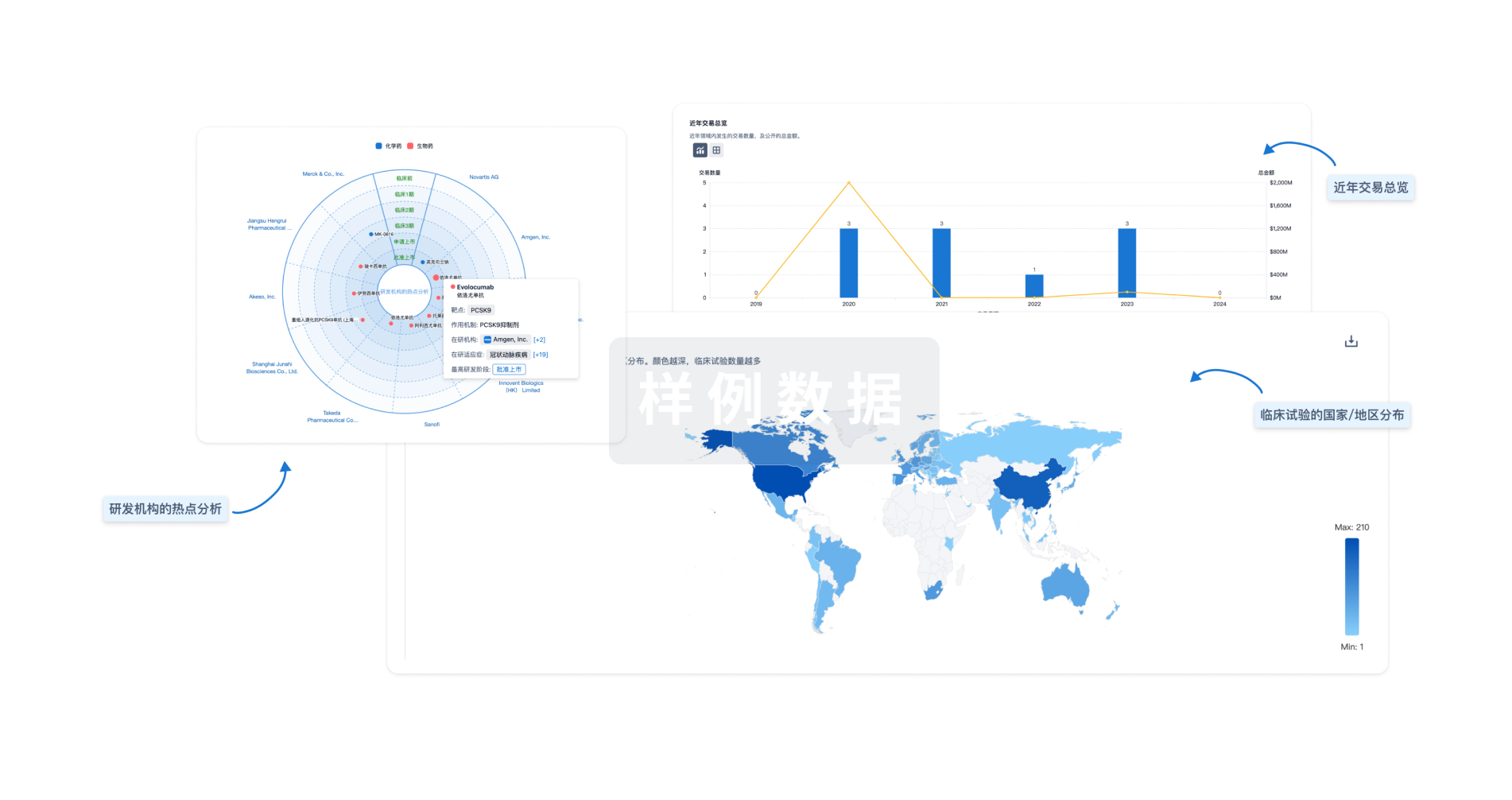预约演示
更新于:2025-05-07
PI3
更新于:2025-05-07
基本信息
别名 cementoin、ELAFIN、Elastase-specific inhibitor + [10] |
简介 Neutrophil and pancreatic elastase-specific inhibitor of skin. It may prevent elastase-mediated tissue proteolysis. Has been shown to inhibit the alpha-4-beta-2/CHRNA2-CHRNB2 nicotinic acetylcholine receptor and to produce a weak inhibition on Kv11.1/KCNH2/ERG1 and on the transient receptor potential cation channel subfamily V member 1 (TRPV1) (PubMed:29483648). |
关联
100 项与 PI3 相关的临床结果
登录后查看更多信息
100 项与 PI3 相关的转化医学
登录后查看更多信息
0 项与 PI3 相关的专利(医药)
登录后查看更多信息
1,657
项与 PI3 相关的文献(医药)2025-12-01·Molecular Genetics and Genomics
Construction of a prognostic risk model for clear cell renal cell carcinomas based on centrosome amplification-related genes
Article
作者: Ye, Zhenzhong ; Dai, Rongyang ; He, Jinwei ; Zhou, Bingru ; Ma, Wenzhe ; Luo, Lin ; Liu, Fengye ; Wan, Ying ; Tang, Long
2025-04-01·The Journal of Pathology
Article
作者: Kinoshita, Takahiro ; Ohdan, Hideki ; Sakashita, Shingo ; Yamamoto, Yusuke ; Tanabe, Kazuaki ; Kitaoka, Takumi ; Nakamura, Yuka ; Morisue, Ryo ; Hashimoto, Hiroko ; Sakamoto, Naoya ; Ukai, Shoichi ; Ochiai, Atsushi ; Yasui, Wataru ; Harada, Kenji ; Kondo, Ryotaro ; Maruyama, Ryota ; Shitara, Kohei ; Kojima, Motohiro ; Ishii, Genichiro ; Ishikawa, Shumpei
2025-04-01·Indian Journal of Clinical Biochemistry
miR-335-5p Inhibits EMT and PI3K/AKT Pathways via MARCH8
Article
作者: Sharma, Rinu ; Saraya, Anoop ; Suyal, Geetika ; Bano, Arjumand
9
项与 PI3 相关的新闻(医药)2025-04-01
·奇点网
*仅供医学专业人士阅读参考阿尔茨海默病(AD)的认知能力下降速度在不同人中差异极大,症状发作年龄在40-100岁之间,而从轻度认知障碍(MCI)进展到AD源性痴呆症的时间在2-20年内。目前通过脑脊液和PET对生物标志物β淀粉样蛋白(Aβ)和tau的评估已经一定程度上可以帮助进行AD的诊断和进展预测。然而,Aβ和tau只能解释AD认知障碍方差中的20-40%。此前提出的“A/T/N”(Aβ/tau/神经变性)的生物标志物框架中,神经变性也只能有限地解释除Aβ和tau之外的一小部分,因此,这表明存在其他的AD源性痴呆症驱动因素。在今天的《自然·医学》杂志中,来自斯坦福大学的研究团队发表最新研究成果[1],在脑脊液蛋白质组学分析中,突触蛋白具有独立于Aβ和tau的最强认知障碍相关性。利用机器学习,他们发现,脑脊液YWHAG:NPTX2突触蛋白比值相比pTau181:Aβ42和tau PET等金标准标志物,能够解释更多的认知障碍方差。脑脊液YWHAG:NPTX2会随年龄增长而增加,在常染色体显性AD(ADAD)突变携带者中,大约开始于估计的症状出现前20年。在超过15年的随访中,脑脊液YWHAG:NPTX2能够很好地预测Aβ和磷酸化tau双阳性(A+T+)的认知正常者,以及A+T+ MCI进展为痴呆症。这些结果强调了脑脊液YWHAG:NPTX2是认知弹性与AD发病和进展的稳定预后生物标志物,也进一步暗示了突触功能障碍是AD源性痴呆症的一个核心驱动因素。这项研究使用6个前瞻性AD病例对照队列的3397名参与者的脑脊液样本,进行了大规模的蛋白质组学分析。研究人员共鉴定出了675个显著增加的蛋白和721个显著减少的蛋白,主要在突触蛋白中富集,增加最多的包括YWHAG、YWHAZ和YWHAH等,YWHA家族与pTau181:Aβ42密切相关。减少最多的蛋白包括NPTX2、NPTXR和SLITRK1等,其中排名第一的NPTX2此前被发现过在AD神经元中表达下降。研究人员训练了一个惩罚线性模型,根据214种突触蛋白的水平来预测认知障碍的严重程度,并使用递归特征消除对模型进行了简化,该模型确定YWHAG和NPTX2之间接近1:1的差异是认知障碍的合适特征。在各队列中,YWHAG:NPTX2与认知障碍的关联都是一致的,包括散发性和早发性AD,以及不同性别亚组。各队列中,YWHAG:NPTX2在不同人群中的分布在区分痴呆症患者和认知正常个体时,YWHAG:NPTX2的曲线下面积(AUC)为0.97。在A+T+个体中,YWHAG:NPTX2水平低(最低的25%)者中62%认知正常,37%有MCI,而水平高(最高的25%)者中仅有4%认知正常,46%患痴呆症。线性回归显示,在A+T+个体中,pTau181:Aβ42解释了认知障碍中10%的方差,YWHAG:NPTX2解释了36%,额外解释了除pTau181:Aβ42外的27%。类似的情况也发生在YWHAG:NPTX2与tau PET(额外11%),以及脑脊液神经丝轻链蛋白(NfL)、生长相关蛋白43(GAP-43)和神经颗粒素(额外28%)的比较中。这些结果表明,YWHAG:NPTX2水平代表一种“病理”,与以前报道的AD神经变性和突触功能障碍生物标志物不同,并且与认知障碍的关系更加密切。研究人员还发现,YWHAG:NPTX2在成年后早期就会随年龄增加,它的变化发生在pTau181:Aβ42变化前约30年。无论是散发性AD还是ADAD,相比正常衰老,AD进展期间,YWHAG:NPTX2增加都有数倍的加速,在ADAD中,发病前约22年,YWHAG:NPTX2就会有显著增加。在衰老过程中,YWHAG:NPTX2和pTau181:Aβ42随年龄的变化这种逐步的变化意味着YWHAG:NPTX2可能能够作为预测AD发病和进展的标志物。在15年的随访中,校正基线认知障碍、pTau181:Aβ42、脑脊液NfL和神经颗粒素、年龄、性别,以及APOE4后,YWHAG:NPTX2能够很好地预测A+T+ MCI人群向轻度痴呆症的进展,YWHAG:NPTX2每增加一个标准差,认知下降风险增加124%。类似的,YWHAG:NPTX2也能够预测A+T+认知正常者未来发生痴呆症的风险,每增加一个标准差,风险即增加197%。YWHAG:NPTX2对进展为痴呆症的预测最后,鉴于近年来血浆AD生物标志物的可用性增加,研究人员也结合机器学习,尝试提取出了一组基于血浆蛋白质组学的认知障碍生物标志物,包含了随认知障碍增加的蛋白CPLX2、PTPRD和PI3等,以及随认知障碍下降的蛋白NPTXR、SEZ6L和CD93等,它们与脑脊液YWHAG:NPTX2具有相关性。综上所述,脑脊液中的突触蛋白具有非Aβ和tau依赖性的与AD相关认知障碍的关联,突触蛋白YWHAG:NPTX2水平变化代表了一个与认知功能障碍过程有关的生物过程,而目前我们对此还知之甚少,还需要进行机制研究以阐明这一病理学的发展。同样在今天,美国圣路易斯华盛顿大学医学院和瑞典隆德大学的研究团队发表了另一篇AD生物标志物的研究[2],他们发现,血浆MTBR-tau243能够特异性地反映tau的缠结病理,在MCI和痴呆症阶段呈现阶段式的升高,这一标志物与tau PET和认知能力密切相关,优于目前常用的其他血浆tau标志物(p-tau217和p-tau205)。生物标志物的进展对于AD的诊断、治疗药物研发、疗效评估和临床试验受试者筛选都有着重要意义,期待它们未来在临床中的应用。参考文献:[1] Oh, H.SH., Urey, D.Y., Karlsson, L. et al. A cerebrospinal fluid synaptic protein biomarker for prediction of cognitive resilience versus decline in Alzheimer’s disease. Nat Med (2025). https://doi.org/10.1038/s41591-025-03565-2[2] Horie, K., Salvadó, G., Koppisetti, R.K. et al. Plasma MTBR-tau243 biomarker identifies tau tangle pathology in Alzheimer’s disease. Nat Med (2025). https://doi.org/10.1038/s41591-025-03617-7本文作者丨应雨妍
临床结果临床1期
2024-11-05
·今日头条
【导读】
术中放疗(intraoperative radiation therapy, IORT)引发的免疫反应的综合分析尚不完整。
11月4日,南方医科大学与中山大学以及南华大学研究人员合作共同在期刊《Advanced Science》上发表了研究论文,题为“Landscape of the Peripheral Immune Response Induced by Intraoperative Radiotherapy Combined with Surgery in Early Breast Cancer Patients”,本研究中, 研究人员对IORT前后的早期乳腺癌患者的外周血单个核细胞(PBMCs)进行单细胞RNA测序和单细胞T细胞受体测序。IORT联合手术(定义为IORT+手术)后,PBMC计数保持稳定,T细胞、单核吞噬细胞和浆细胞比例升高,中性粒细胞比例降低。术中放疗后CD8Teff_GZMK细胞的细胞毒性评分显著升高。IORT后CD8Teff_GZMK细胞与其他免疫细胞通过MIF_CD74和MIF_TNFRSF14的交流减少。治疗后T细胞克隆明显扩增。IORT+手术可部分抑制中性粒细胞的抗肿瘤作用。流式细胞术分析和共培养实验被用于更深入地研究T细胞的功能变化。IORT+手术显著增强了T细胞的细胞毒活性。阻断PD-1后,术中放疗后PBMC的T细胞活性高于术前PBMC。
这项研究强调了IORT对免疫细胞的影响,为乳腺癌的靶向免疫反应提供了新的见解。
https://onlinelibrary.wiley.com/doi/full/10.1002/advs.202308174
背景信息
01
筛查技术的发展提高了早期乳腺癌的检出率。保乳手术联合外放疗已成为治疗早期乳腺癌的标准方法。放疗有助于提高局部疾病管理和总生存率。乳腺癌保乳术后辅助放疗是在伤口愈合或完成化疗后进行。全乳放疗常规计划为50Gy/25次,总治疗时间为5 ~ 7周。放疗给患者带来不便,增加了经济成本。部分患者可能因术后并发症导致放疗延迟。术中放疗(Intraoperative radiotherapy, IORT)是在外科手术过程中实施的高剂量照射。IORT避免了术后组织瓣移位导致的瘤床定位偏差,提高了瘤床推放的准确性。术中放疗可有效管理瘤床,而瘤床是肿瘤复发风险较高的区域。它还降低了因化疗而导致的放疗延迟而导致的肿瘤增殖风险。IORT与全乳放疗在生存和不良反应方面有相似的结果,但完成治疗所需的时间更短。在这种情况下,IORT是早期乳腺癌保乳手术患者的良好选择。
肿瘤微环境(tumor microenvironment, TME)受多种因素的影响。遗传改变、表观遗传修饰以及不同细胞类型之间的相互作用导致了TME调控的复杂性。此外,放疗可以改变细胞表型和组织成分,从而影响癌细胞生存和肿瘤微环境。辐射不仅影响靶细胞,也影响未受辐射的邻近细胞,这种现象被称为辐射诱导的旁效应。在一些已发表的研究中,IORT已被证明影响肿瘤细胞和伤口渗出液。单次高剂量IORT通过触发免疫系统诱导癌细胞的免疫原性细胞死亡。研究人员进行了流式细胞术检查,观察到IORT后3周,NK CD56+高CD16+亚群显著上升。然而,关于IORT触发的外周免疫反应的信息仍然未知。
IORT抑制了中性粒细胞的功能
02
研究人员通过单细胞RNA测序识别出三种中性粒细胞群:中性粒细胞_IFIT1细胞、中性粒细胞_DUSP6细胞和中性粒细胞_S100A1细胞。在图1B中展示了中性粒细胞群在IORT+手术前后差异表达基因的热图。中性粒细胞_IFIT1细胞表达ISG15、MX1和IFIT1;中性粒细胞_DUSP6细胞表达PI3、CCR3和SIGLEC10;中性粒细胞_S100A12细胞表达S100A12、MMP9和RFLNB。图1C展示了每个样本中中性粒细胞_IFIT1细胞、中性粒细胞_DUSP6细胞和中性粒细胞_S100A12细胞的一般分布直方图。IORT+手术后,总中性粒细胞数减少,中性粒细胞_IFIT1细胞和中性粒细胞_DUSP6细胞均显示出减少的趋势。然后,研究人员进一步评估了每个中性粒细胞群在IORT+手术前后的功能变化。IORT+手术后,所有中性粒细胞群的趋化性、中性粒细胞激活和吞噬能力评分显著降低。IORT+手术对中性粒细胞衰老评分没有显著影响。根据KEGG分析,IORT+手术后的Neutrophils_IFIT1细胞在与NOD样受体信号通路、坏死性凋亡、抗原加工与呈递以及NF-κB信号通路相关的基因上显示出特定的富集。IORT+手术后的Neutrophils_DUSP6细胞在与趋化因子信号通路、细胞因子-受体相互作用、NF-κB信号通路、白细胞跨内皮迁移、催产素信号通路、IL-17信号通路、坏死性凋亡、Th17细胞分化以及NOD样受体信号通路相关的基因上显示出特别的富集。经IORT+手术处理后的中性粒细胞_S100A12细胞在与癌症相关的IL-17信号通路、中性粒细胞外泌体形成、NOD样受体信号通路、血小板激活、PD-L1表达和PD-1检查点通路、细胞凋亡、趋化因子信号通路、Th17细胞分化、HIF-1信号通路和TNF信号通路等方面显示出特定的富集。
图1:中性粒细胞的特性
IORT增强CD8+T细胞活性并与PD-1阻断产生协同作用
03
研究人员收集了六名乳腺癌患者在IORT+手术前后的PBMCs,用于后续实验。研究人员通过流式细胞术分析了PBMCs中CD8+ T细胞中GZMK+细胞的频率和CD8+ T细胞中IFN-γ+细胞的频率。结果显示,IORT+手术后CD8+ T细胞中GZMK+细胞和IFN-γ+细胞的比例显著增加(GZMK+ P <0.0001; IFN-γ+ P = 0.0012)。这些发现表明,IORT+手术后CD8+ T细胞的细胞毒性增强。PD-1是一种协同抑制分子,在T细胞功能中起着关键作用。阻断PD-1可恢复T细胞功能并促进有效的抗肿瘤反应。将激活的T细胞与MDA-MB-231或MCF-7细胞以E:T比例为3:1共培养48小时,不加或加入10微克/毫升的帕博利珠单抗(PD-1抑制剂),然后用结晶紫染色。研究人员发现,IORT+手术增强了人T细胞介导的细胞毒性。此外,在IORT+手术后用帕博利珠单抗培养的PBMCs表现出比在IORT前收集的PBMCs更强的人T细胞介导的细胞毒性。这些发现表明,当阻断PD-1时,接受IORT+手术治疗的外周T细胞会协同激活。
研究意义
04
这项研究描述了术中放疗+手术引起的系统性免疫反应,为识别增强免疫反应的潜在靶点铺平了道路。
【参考资料】
https://onlinelibrary.wiley.com/doi/full/10.1002/advs.202308174
【关于投稿】
转化医学网(360zhyx.com)是转化医学核心门户,旨在推动基础研究、临床诊疗和产业的发展,核心内容涵盖组学、检验、免疫、肿瘤、心血管、糖尿病等。如您有最新的研究内容发表,欢迎联系我们进行免费报道(公众号菜单栏-在线客服联系),我们的理念:内容创造价值,转化铸就未来!
转化医学网(360zhyx.com)发布的文章旨在介绍前沿医学研究进展,不能作为治疗方案使用;如需获得健康指导,请至正规医院就诊。
热门推荐活动 点击免费报名
🕓 上海|11月15日-16日
▶ 2024第一届中国类器官转化医学大会
🕓 上海|11月21日-24日
▶ 第七届上海国际肿瘤内科学论坛
🕓 全国|2024年12月-2025年03月
▶ 中国转化医学产业大会
🕓 上海|2025年02月28日-03月01日
▶ 第四届长三角单细胞组学技术应用论坛暨空间组学前沿论坛
点击对应文字 查看详情
免疫疗法临床研究
2024-09-24
·今日头条
【导读】
尽管据报道瘤内微生物组对癌症进展有影响,但其在该亚型中的作用仍不清楚。这项研究旨在使用来自The Cancer Genome Atlas的RNA-Seq数据,来表征肾透明细胞癌的微生物景观和特征。
2024年9月22日, 南京医科大学第一附属医院Sun Lejia团队在期刊《Heliyon》上发表了题为“Tumor microbiota of renal cell carcinoma affects clinical prognosis by influencing the tumor immune microenvironment”的研究论文。基于微生物组的亚型揭示了肿瘤微生物组、临床预后和肿瘤微环境之间的相关性,
表明肿瘤内微生物群是肾透明细胞癌有潜力的预后生物标志物。
https://www.cell.com/heliyon/fulltext/S2405-8440(24)14341-1
研究背景
01
迄今为止,癌症仍然是一个主要的全球健康问题,肾细胞癌(RCC)在所有癌症类型中排名第10。大约30%的RCC患者在晚期被诊断出来,5年生存率仅为10%。由于对常规放疗和化疗缺乏敏感性,转移性肾透明细胞癌(KIRC)是最常见的RCC 亚型,患者接受免疫治疗和靶向治疗作为一线治疗。最近的研究表明,微生物群在包括RCC在内的多种癌症的进展和治疗反应中,起着重要作用。
尽管瘤内微生物组已经在各种癌症中得到表征,但与RCC特异性相关的微生物组,仍未得到充分研究。尿路感染已被确定为RCC发展的可改变危险因素。2022年的一项研究,揭示了细菌载量与PU.1巨噬细胞之间存在负相关关系,为了解细菌如何影响RCC相关免疫细胞的表型提供了见解。
在这项研究中,KIRC转录组测序数据和患者临床数据来自癌症基因组图谱(TCGA)数据库。随后,团队在长期总生存期(OS)与短期总生存期(OS)患者之间鉴定出差异丰富的微生物,并构建基于Cox回归的风险评分特征。团队进行了进一步的分析,包括差异基因表达和基因集富集,
以阐明这些风险相关微生物影响肿瘤免疫反应和疾病预后的潜在免疫原性机制。
研究进展
02
已鉴定的预后相关微生物与免疫相关基因具有显著相关性
通过特别关注免疫相关基因,团队确定了30个感兴趣的基因。其中,24个基因在高危人群中上调,主要与抗菌功能、炎症和自然免疫有关。示例包括PI3、LBP、IFNG和趋化因子相关基因CXCL5、SAA1和SAA2,这些基因可能在驱动炎症反应和肿瘤发展中发挥关键作用。相反,在高危组中,有6个基因下调,主要与适应性免疫有关。值得注意的例子是免疫球蛋白家族基因,如IGKV1-16、IGKV1D-17和IGKV2D-24,它们可能参与针对肿瘤的适应性免疫反应。
大多数微生物相关基因与鉴定的免疫相关基因呈负相关,并参与抗菌反应、炎症诱导、先天免疫和肿瘤促进。相反,
与免疫相关基因呈正相关的微生物相关基因,
主要表现出与抗体结合、适应性免疫诱导和肿瘤抑制相关的功能。这表明与免疫相关基因呈负相关的微生物,可能通过促进抗菌反应、炎症和自然免疫,导致患者预后变差;而与此类基因呈正相关的微生物,可能会增强适应性免疫,从而获得更好的患者预后。
差异丰度微生物与免疫功能基因相关
基于微生物的风险评分可以将患者分为两个不同的组,其特征是免疫细胞功能不同
上调的基因富含与急性反应、炎症反应、抗菌免疫和表皮细胞分化相关的功能,这些功能与肿瘤生长有关,而下调的基因与免疫球蛋白复合物和离子转运过程有关。上调的基因通路是那些参与表皮生长、核分裂、趋化因子、抗菌反应和急性炎症的基因通路,而下调的基因通路参与抗体结合、离子转运和适应性免疫反应。
不良预后相关微生物与单核细胞、巨噬细胞和肥大细胞活性有关,
它们在诱导先天性炎症反应中起关键作用。相反,阳性预后相关微生物与B细胞和T细胞相关,B细胞和T细胞是适应性免疫反应的关键参与者。
生存风险评分区分具有不同免疫相关特征的高危和低危患者
研究结论
03
这项研究提出了几个关键的见解。首先,与邻近非肿瘤组织的比较分析表明,肿瘤微生物群的α和β多样性降低,微生物组成不同。此外,团队确定了10个在总生存期长和短患者之间显著不同的微生物属,并用于制作基于微生物组的预后风险特征。这种特征有助于识别2种不同的微生物组驱动的亚型,这些亚型与不同的临床结果和免疫微环境相关:4种高危微生物与促肿瘤急性炎症有关,而6种低风险微生物激活过继免疫以阻止肿瘤进展。
总之,
微生物群、预后和肿瘤免疫之间的关联,
突出了利用肿瘤内微生物群作为预后生物标志物的潜力。未来的关键方面,包括阐明肿瘤内微生物群与肿瘤微环境相互作用的基本机制,
并确定关键微生物作为潜在的治疗靶点。
此外,需要真实世界的临床研究,来证实这些微生物在预测患者预后和优化免疫治疗反应方面的实际效用。
参考资料:
1.Xue, C. ∙ Chu, Q. ∙ Zheng, Q. ...
Current understanding of the intratumoral microbiome in various tumors
Cell Rep Med. 2023; 4, 100884
2.Siegel, R.L. ∙ Miller, K.D. ∙ Jemal, A.
Cancer statistics
CA Cancer J Clin. 2019; 69:7-34 2019
【关于投稿】
转化医学网(360zhyx.com)是转化医学核心门户,旨在推动基础研究、临床诊疗和产业的发展,核心内容涵盖组学、检验、免疫、肿瘤、心血管、糖尿病等。如您有最新的研究内容发表,欢迎联系我们进行免费报道(公众号菜单栏-在线客服联系),我们的理念:内容创造价值,转化铸就未来!
转化医学网(360zhyx.com)发布的文章旨在介绍前沿医学研究进展,不能作为治疗方案使用;如需获得健康指导,请至正规医院就诊。
热门推荐活动 点击免费报名
🕓 上海|11月15日-16日
▶ 2024第一届中国类器官转化医学大会
点击对应文字 查看详情
诊断试剂临床研究微生物疗法
分析
对领域进行一次全面的分析。
登录
或

生物医药百科问答
全新生物医药AI Agent 覆盖科研全链路,让突破性发现快人一步
立即开始免费试用!
智慧芽新药情报库是智慧芽专为生命科学人士构建的基于AI的创新药情报平台,助您全方位提升您的研发与决策效率。
立即开始数据试用!
智慧芽新药库数据也通过智慧芽数据服务平台,以API或者数据包形式对外开放,助您更加充分利用智慧芽新药情报信息。
生物序列数据库
生物药研发创新
免费使用
化学结构数据库
小分子化药研发创新
免费使用